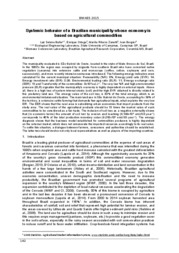Systemic behavior of a Brazilian municipality whose economy is based on agricultural commodities.
Systemic behavior of a Brazilian municipality whose economy is based on agricultural commodities.
Author(s): BULLER, L. S.; ORTEGA, E.; ZANETTI, M. R.; BERGIER, I.
Summary: The municipality evaluated is São Gabriel do Oeste, located in the state of Mato Grosso do Sul, Brazil. In the 1960's the region was occupied by migrants from southern Brazil who have converted native vegetation (savanna) into extensive cattle and monocrops (coffee, cotton, soybeans and corn, successively), and more recently intensive swine was introduced. The following emergy indicators were calculated for the current municipal situation: Renewability (%R): 8%; Emergy yield ratio (EYR): 14; Emergy investment ratio (EIR): 0.08; Environmental loading ratio (ELR): 11; Emergy exchange ratio (EER): 13 and Transformity of the commodities: 8x105seJ.J-1. The very low %R and high environmental pressure (ELR) signalize that the municipality's economy is highly dependent on external inputs. Above all, there is a high loss of system internal stocks (soil) and the high EYR obtained is directly related to this predatory land use. The emergy value of the soil loss is 83% of the total emergy, which is an environmental imbalanced situation. The main land use in São Gabriel do Oeste, accounting for 39% of the territory, is extensive cattle farming that demands few agricultural inputs, what explains the very low EIR. The EER shows that the rural area is subsidizing urban economies that import products from the study area. The real value of the agricultural products should be 13 times the market value of such commodities to be considered as a fair trade. The inclusion of soil loss as a negative externality shows that (in economic terms) the amount of soil lost by erosion and leaching (4,149x106 emUSD.year-1) corresponds to 46% of the total production monetary value (9,018x106 emUSD.year-1). The emergy diagnosis shows that the business model established for commodities producers is highly dependent on the external market, which does not remunerate the imported resources accordingly to its real value. To settle this situation, a dialogue between farmers, consumers and authorities should be established. The latter two should involve not only local representatives as well as players of the importing countries.
Publication year: 2015
Types of publication: Paper in annals and proceedings
Unit: Embrapa Pantanal
Related content
Observation
Some of Embrapa's publications are published as ePub files. To read them, use or download one of the following free software options to your computer or mobile device. Android: Google Play Books; IOS: iBooks; Windows and Linux: Calibre.
Access other publications
Access the Agricultural Research Database (BDPA) to consult Embrapa's full library collection and records.
Visit Embrapa Bookstore to purchase books and other publications sold by Embrapa.

